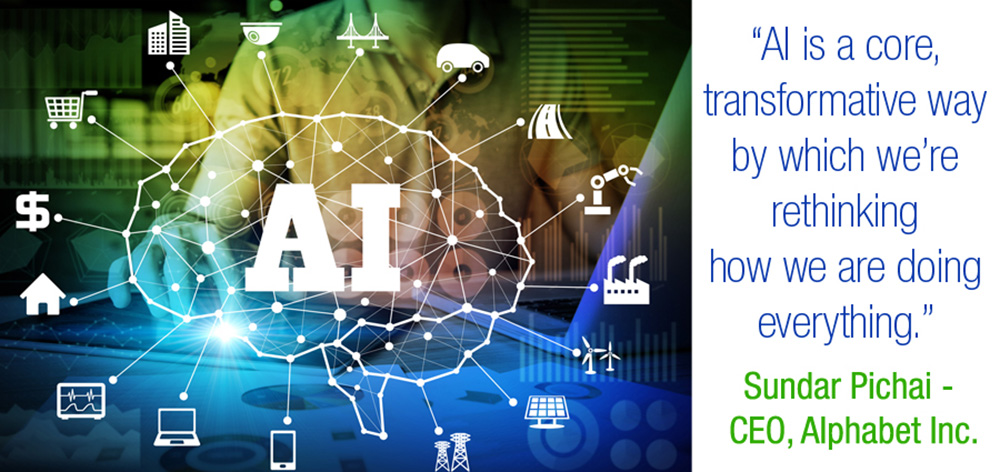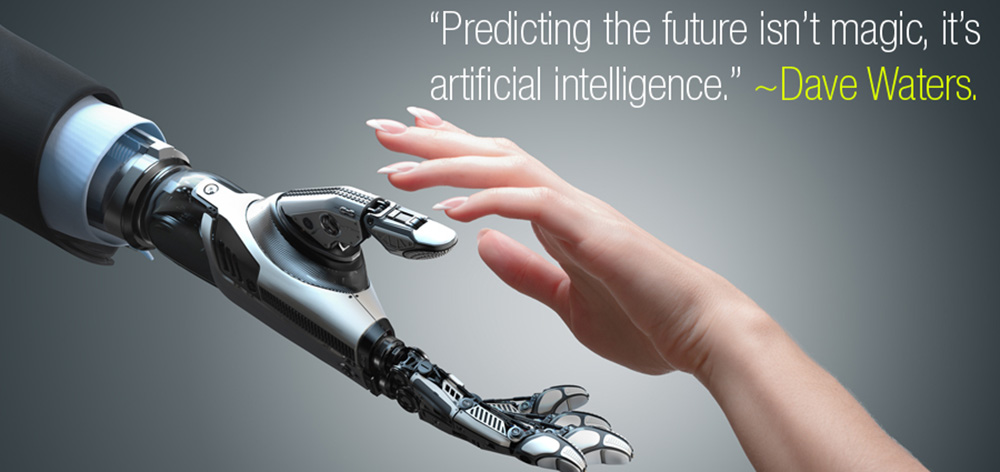Technology is the future of human lives. Over the years, advancements in this field have continued to reshape the world we live in, and it is not stopping now. On a daily basis, developers are working relentlessly to create new software and algorithms that will transform the way people communicate, treat patients, do business, fight crime, and generally exist. AI is at the core of this technological future. With AI, some aspects of the fantasy-world projected in science-fiction movies will soon become a reality.
Although, a new phenomenon in the mainstream environment, AI technology dates to early civilizations when Egyptian and Chinese engineers invented automatons. The modern beginnings of AI are traced to 1956, the year it was formally established. Since then, AI has undergone several development phases. Presently, it refers to machines with the abilities to carry out human-like activities, solve difficult problems and enhance the decision-making process. This technology can also perform advanced functions and tasks that would otherwise be overwhelming to humans.
AI is poised to radically improve data collection and analysis, business operations, manufacturing processes, politics, household tasks, and so much more. The effects of AI are far-reaching and will impact every human domain.
What is AI: Where are We Today and What Does the Future Look Like?
Despite the frequent mainstream and online reports and coverage of AI technology, many people, especially in America, do not have a clear-cut understanding of what this technology is and the ways it is revolutionizing their world.
Technically, Artificial Intelligence (AI) is a broad spectrum of computer science concerned in developing smart machines capable of replicating and simulating and human intelligence. In other words, AI is an umbrella term for machines that can think, behave, and perform jobs like humans, without human intervention or input. Sometimes with better precision, accuracy and effectiveness, all AI devices operate using different levels of machine and deep learning technology.
Today, AI is all around us, it is integrated into our daily lives, even though many people are oblivious to it. Think of Facebook, how this platform connects everyone from everywhere, facilitates communication in real-time and provides features and packages that meet specific consumer needs.

The application of AI software makes all these possible. Through machine learning technologies, Facebook fetches personal data of its users, such as behavior patterns, tastes, lifestyle and interest and uses them for exorbitant gains. AI technology has also been adopted by popular companies such as Apple (Siri), Amazon (Alexa), Telsa (semi-automated vehicles), Nest, Pandora, Netflix, and much more.
This widespread acceptance is also reflected in the current market value of AI software. A report has revealed that, in 2019, the global artificial intelligence market was worth 28.42 billion USD and is projected to reach 40.27 billion USD in 2020. The same report also postulates that by 2023, the AI market will be valued at 99.98 billion USD with a compound annual growth rate of 34.86%.
In the future, AI technology will improve household and workplace security, intelligently combat cybercrime and other fraudulent activities. It will also immensely increase employee productivity and assist businesses to provide customized solutions to individual consumer needs. Experts also expected AI-enabled devices to have the ability to apply a causal reasoning approach to problem-solving rather than observed correlations alone.
Impacts on Education
The emergence of new technology has had profound impacts on learning and teaching processes. Artificial Intelligence systems are poised to amplify these impacts. AI creates accessibility to a wealth of knowledge that was previously impossible to access. As a result, it widens the scope of possibilities and opportunities available to students and teachers.
Today, AI technology is used to understand the emotions of a child at a particular time. This helps teachers to deal better with students and enhance the learning process. AI can also eliminate or greatly reduce the stress and time spent on administrative work such as grading tests, papers and homework, planning lessons through configurable software that can create lesson plans and process and analyze scores.
In addition, AI will improve personalized and customizing teaching, tutoring, and learning. Every child has unique educational needs, and individualized learning can address those needs and improve their general academic performance.
The future of the education system will expand classroom seats significantly at a lower cost providing 50% of the classes remotely while partnering with technology companies to embrace adaptive learning technology. As we have experienced during the pandemic in 2020, however, people still desire the human interaction afforded to them through in-person classes. So, while AI can and will expand the virtual nature of education and online learning, students will find a new norm of in-person social interaction to enhance their educational experiences.

Impacts on Businesses
The reduced cost, optimized operations, data-driven decisions, improved customer service, and increased productivity are some of the benefits of AI in today’s business world. According to a McKinsey report, financial services is one industry that has significantly adopted AI practices. Consequently, some firms have witnessed a profit margin of over ten percent than the industry average. A study on the business impacts of AI in 12 developed countries, found that AI can enhance productivity by 40%. In addition to productivity, AI is also expected to improve profitability and enhance consumer services.
One of the most significant impacts of AI on business is the massive takeover of mundane and repetitive jobs by robots. This transition is not only witnessed in the manufacturing and assembly-line industries but also in many business warehouses. Amazon, for instance, now has several automated warehouses, where thousands of mobile robots move inventory from one point to another, a job that was previously done by humans.
Machine learning AI devices can collect and synthesize a vast amount of data through connected devices and things. These data can be utilized by manufacturing companies to monitor and improve the functions of their asset. Anomalies within processes will be detected on time and in the future, AI will have the ability to correct these problems without human intervention. This is what experts refer to as a shift from perception to action in AI. Among other things, AI will improve business’ response to consumer needs, encourage individualized services and generally boost consumer experience.
A survey of 3000 executives across 21 countries revealed that 83% of businesses consider AI as a strategic priority today. Also, IDC’s predictions suggest that global spending on cognitive and AI systems will reach $57.6 billion in 2021.
Impacts on Workforce
Over the years, there has been controversy on the impact that AI technology will have on the workforce. Some experts strongly believe that automation of business will extremely reduce human labour and massive unemployment. Several studies have also shown that AI technology will displace a huge percentage of employees in the coming years.
According to Oxford Economics, 25 million manufacturing workers will lose these jobs to robots in 2030. On the other hand, other analysts are optimistic about these impacts and suggest that even though AI may pose a high risk to jobs, they also have the potential of generating many new ones. In the same vein, a study reveals that by 2022, AI will replace 75 million workers but also create 133 new jobs. Away from job replacement and opportunities, AI will lead to more qualified workers that can handle high-level tasks.
A Mckinsey study suggests by 2030, one-third of the current jobs will be replaced by AI technologies, such as intelligent agents and robots, and in the longer term will replace almost all human jobs, providing every human with AI-produced treasure. Already, countries such as Switzerland and Finland are considering guaranteed basic income for everyone, free education, and healthcare. The US has a long way to go before it is ready to adopt such social policies, and we will no doubt evolve a new norm for employment expansion beyond AI.
Impacts on the Society
There is no doubt that AI will improve the quality of life of every member of society. At the office, AI will ensure the safety of individuals by taking over dangerous tasks and protecting them for accident-prone areas.

AI can also dramatically improve healthcare with enhanced monitoring and diagnostic capabilities. It will also guarantee personalized medicine and treatment plans that will cater to individual patients’ needs.
Through smart cars, with level 5 automation functionalities, the rate of road accidents will drop drastically, and congestion and traffic jams will be a thing of the past. AI will also enable smart houses, smart cities, smart factories, and smart industries. Cities in the U.S. and around the world have already begun to deploy the use of AI applications for public safety and security. A study by Ernst & Young in 2020 reveals that law enforcement agencies in cities are using AI to predict and prevent crime, support criminal investigations, combat terrorist threats, respond to natural disasters and maintain crowd and traffic control.
Conclusion
Despite the enormous benefits AI technology offers, there have been concerns about some adverse impacts AI will have on ethics, fairness, justice, and freedom. Presently, AI technology and devices exert immense power and control over human lives. They set rules that we must follow and are used by large tech corporations to monitor and gather data on the lives of people. Some fear that in the future, these corporations that control AI technologies will use obtained data, to negatively persuade, influence and manipulate everyone else. Therefore, there is need for the government to effectively regulate AI technology and set necessary boundaries.
About the author
Dr Srikanth Gaddam is an author, angel investor and a seasoned entrepreneur who launched three successful technology companies in the last seventeen years. Dr Gaddam’ s greatest accomplishment lies in raising ERP Analysts, Inc. from a two-person organization to eighty-five-million-dollar firm. ERP Analysts, Inc. has been recognized as one of the fastest-growing companies by Inc. 5000 for ten years, Deloitte Fast 500, & Business First Fast 50 for several years. ERP Analysts is recognized as a “Best Places to Work” in Ohio for several years (www.erpagroup.com). Dr Gaddam graduated the Doctor of Management (DM) from Case Western Reserve University, MBA from the Ohio State University, and the Owner President Management program (OPM 43) from Harvard Business School. He is the author of the book “Destination Success: Discovering the Entrepreneurial Journey” and also co-author of “Roadmap to Success,” with Deepak Chopra, Ken Blanchard, and other entrepreneurial leaders.





